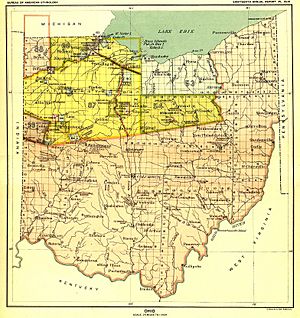Treaty of Fort Meigs facts for kids
The Treaty of Fort Meigs, also known as the Treaty of the Maumee Rapids, was a very important agreement signed in Ohio. It was the biggest deal the United States made with Native American tribes in Ohio since the Treaty of Greenville in 1795. This treaty meant that Native American tribes gave up almost all their remaining land in northwestern Ohio. It was the largest amount of Native American land bought by the United States in the Ohio area.
Contents
What Was the Treaty of Fort Meigs?
This treaty was signed on September 29, 1817, at Fort Meigs. It was an agreement between leaders and warriors from several Native American tribes and representatives from the United States. The tribes involved were the Wyandot, Seneca, Delaware, Shawnee, Potawatomi, Ottawa, and Chippewa.
Who Signed the Treaty?
The main people who signed for the United States were Lewis Cass, who was the governor of Michigan Territory, and General Duncan McArthur from Ohio. These Native American tribes spoke different languages, like Iroquoian and Algonquian. It's important to remember that these tribes were not all organized in one big group. Many of their members also lived in other areas around the Great Lakes.
The agreement had 21 parts, plus an extra section. These parts explained which lands were given up, which lands were set aside for Native American reservations, and which lands were given to individuals. It also said how much money the United States would pay the tribes.
Land Changes in Ohio
In this treaty, the Native American tribes gave up their claim to about 4.6 million acres of land in northwestern Ohio. This is almost one-sixth of the entire state of Ohio! They also gave up parts of northeastern Indiana and southern Michigan.
What Land Was Given Up?
The land they gave up was bordered by the Fort Industry Treaty Line in the east and the Greenville Treaty Line in the south. The western edge went north from the corner of the Greenville Line, avoiding a small reservation, and then zigzagged to Lake Erie. The northeastern border was Lake Erie itself.
After this treaty, most of Ohio was owned by the United States. Only a few small Native American reservations remained. The border between Native American lands and lands owned by the United States then moved to Indiana.
Land Set Aside for Tribes
The Treaty of Fort Meigs set aside some land for the tribes:
- The Wyandot people received a 12-square-mile area in Upper Sandusky.
- The Seneca people received 30,000 acres on the Sandusky River.
- The Shawnee people received two areas: one 10-square-mile area and another 25-square-mile area, both near Wapakoneta. They also received 48 square miles near the Little Miami and Scioto Rivers.
- The Ottawa people were allowed to use, but not own, two areas: one 5-square-mile area on the Great Auglaize River and one 3-square-mile area on the Little Auglaize River.
The Delaware, Chippewa (Ojibwe), and Potawatomi tribes did not receive any reservations in Ohio under this treaty.
What Did the Tribes Receive?
In return for the land, the United States agreed to pay yearly amounts of money to the different tribes. The amount and length of time for these payments varied. Some tribes also received extra money for damages they suffered during the War of 1812, especially if they had helped the United States.
The treaty also started a new practice: giving land directly to individual Native Americans or even to European Americans. The idea was to encourage them to settle down and farm. However, many Native Americans were used to moving around. When the plan to settle them on reservations didn't work well, the government bought back these reservation lands and sold them to other people. This sometimes led to people trying to unfairly gain from buying and selling this land.
A Link to the University of Michigan
The treaty was signed just five days after the start of building for the new University of Michigan in Detroit. One part of the treaty involved the Chippewa, Ottawa, and Potawatomi tribes giving up 1,920 acres of land to the "college at Detroit." This land could be used or sold by the college. An equal amount of land was also given to St. Anne's Catholic Church in Detroit. This church had been built by French-Canadian settlers long before the area became part of the United States.
At the time, the Michigan government hadn't officially created a college yet. So, the next month, two leaders, Reverend John Monteith and Father Gabriel Richard, officially created the "Catholepistemiad of Michigania" in Detroit. This school was later renamed the University of Michigan in 1821. It moved to a new campus in Ann Arbor, Michigan in 1837.
Important Changes (Addendum)
There was an extra document, called an Addendum, that was also signed on September 29, 1817. In this Addendum, the United States gave the Wyandot, Seneca, Shawnee, and Ottawa peoples more money for their lands. Also, the original treaty terms were changed. Instead of just allowing the Native Americans to use the land, the Addendum gave them full ownership of their reservation lands. This officially created Native American reservations.


